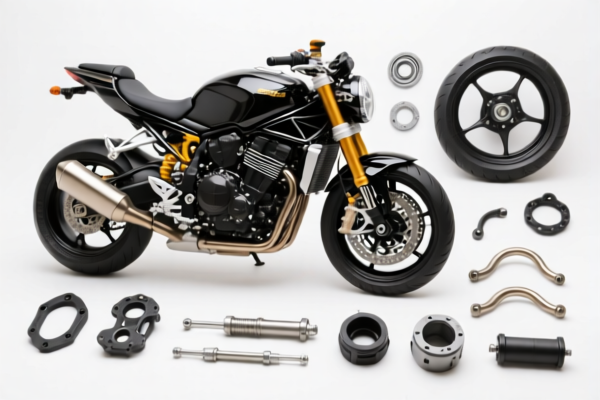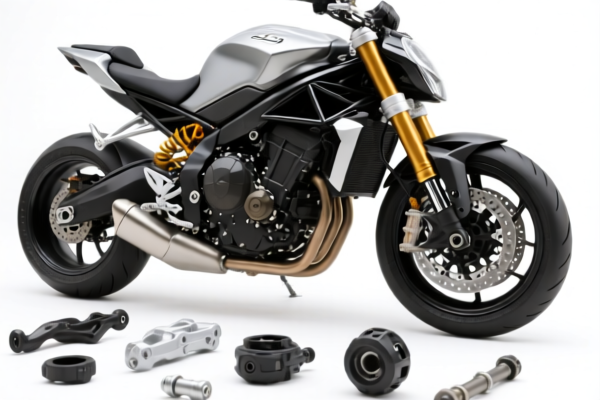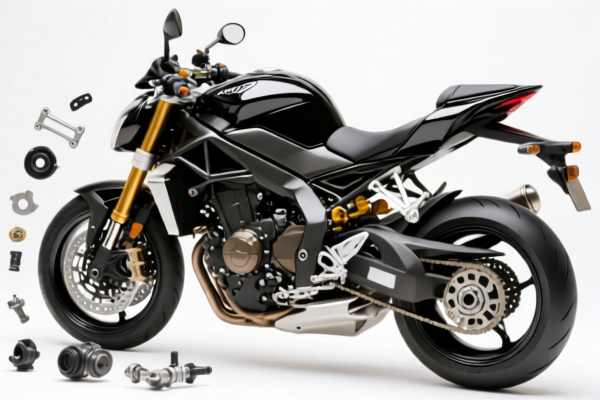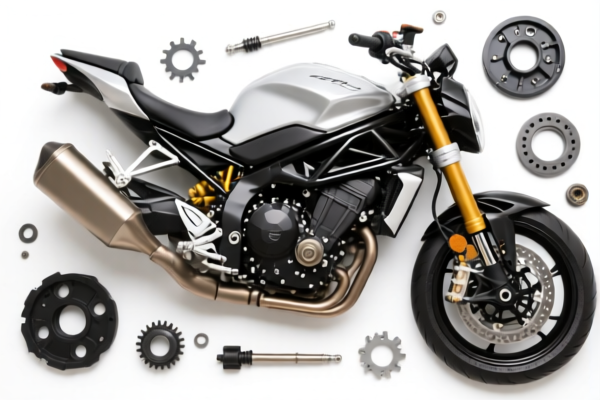| HS Code | Official Doc | Tariff Rate | Origin | Destination | Effective Date |
|---|---|---|---|---|---|
| 8711900100 | Doc | 55.0% | CN | US | 2025-05-12 |
| 8714100010 | Doc | 37.5% | CN | US | 2025-05-12 |
| 8714998000 | Doc | 47.5% | CN | US | 2025-05-12 |
| 7326908688 | Doc | 82.9% | CN | US | 2025-05-12 |
| 7326908605 | Doc | 82.9% | CN | US | 2025-05-12 |
| 7308907000 | Doc | 80.0% | CN | US | 2025-05-12 |
| 7308909560 | Doc | 80.0% | CN | US | 2025-05-12 |




Motorcycle Handlebars
Motorcycle handlebars are a fundamental control component, steering and maneuvering the vehicle while providing a point of control for the rider. They are attached to the fork stem or frame and influence rider posture, handling characteristics, and overall comfort.
Materials
Handlebars are commonly constructed from the following materials:
- Steel: Traditionally used, offering high strength and affordability. However, steel is heavier and more susceptible to corrosion than other materials. Chrome plating is often applied for aesthetics and rust prevention.
- Aluminum Alloy: A popular choice due to its lightweight nature, good strength, and corrosion resistance. Different alloys (e.g., 6061-T6, 7075-T6) offer varying degrees of strength and flexibility. Often anodized for further corrosion protection and color options.
- Carbon Fiber: Provides the lightest weight and highest strength-to-weight ratio, but is significantly more expensive and can be more brittle than steel or aluminum. Typically used in performance applications.
- Titanium: Offers an excellent combination of strength, lightweight properties, and corrosion resistance, but is the most expensive option.
Purpose & Function
The primary functions of motorcycle handlebars are:
- Steering: Handlebars allow the rider to control the direction of the motorcycle by pivoting the front fork.
- Control Mounting: They serve as mounting points for essential controls, including:
- Throttle
- Clutch Lever
- Brake Lever
- Starter Button
- Turn Signals
- Horn Button
- Rearview Mirror Mounts
- Rider Support: They contribute to rider posture and provide leverage for control.
- Impact Absorption: To some degree, handlebars absorb impacts from bumps and vibrations, enhancing rider comfort.
Usage Scenarios & Types
Handlebar types are categorized by shape, height, and intended riding style:
- Standard/Straight Bars: Found on many standard motorcycles, offering a neutral riding position. Provide good all-around control.
- Clip-On Handlebars: Mounted directly to the fork tubes, typically found on sportbikes. Offer a lower, more aggressive riding position, enhancing control and aerodynamics. Subtypes include:
- Clubman Bars: Lower and narrower than standard clip-ons, promoting a more tucked riding position.
- Race Bars: Extremely low and aggressive, designed for track use.
- Cruiser Bars: High, wide bars providing a relaxed, upright riding position, common on cruiser motorcycles. Often feature a pull-back design.
- Touring Bars: Wider and often higher than standard bars, offering increased comfort for long-distance riding. May include integrated fairing mounts.
- MX/Off-Road Bars: Wide and padded bars designed for off-road riding, providing increased leverage and impact absorption. Often feature a crossbrace for added strength.
- Drag Bars: Low, narrow bars typically used on drag motorcycles, promoting a tucked riding position for aerodynamics.
- Ape Hangers: Extremely high bars, popular in custom cruiser applications. Provide a distinctive look but can affect handling.
- Tracker Bars: Slightly wider than standard bars with a slight pull-back, inspired by vintage flat-track racers.
The choice of handlebar type significantly impacts the motorcycle's handling characteristics and rider comfort. Modifying handlebars can alter the geometry of the motorcycle and may require adjustments to other components.
Motorcycle handlebars are components fitted to motorcycles, serving as steering controls. They are typically made of iron or steel, and potentially could be used for electrical grounding.
The following HS codes may be relevant:
- 8711900100: Motorcycles (including mopeds) and cycles fitted with an auxiliary motor, with or without side-cars; side-cars: Other. This code covers motorcycles themselves, and if the handlebars are being imported as part of a complete motorcycle, this code would apply. The total tax rate is 55.0%, comprised of a 0.0% base tariff, a 25.0% additional tariff, and a 30% additional tariff effective April 2, 2025.
- 8714100010: Parts and accessories of vehicles of headings 8711 to 8713: Of motorcycles (including mopeds) Saddles and seats. While primarily for saddles and seats, this code covers parts of motorcycles. The total tax rate is 37.5%, consisting of a 0.0% base tariff and a 7.5% additional tariff, increasing to 30% effective April 2, 2025.
- 7326908688: Other articles of iron or steel: Other: Other: Other: Other. This code covers various iron or steel articles. If the handlebars are imported as individual components not attached to a motorcycle, and are considered general iron or steel goods, this code may be applicable. The total tax rate is 82.9%, with a 2.9% base tariff, a 25.0% additional tariff, and a 30% additional tariff effective April 2, 2025, plus a 25% additional tariff on steel and aluminum products.
- 7326908605: Other articles of iron or steel: Other: Other: Other: Other Rods for electrical grounding (potentially if the handlebars are tubular and could be used for grounding, though this is a stretch). This code specifically covers rods for electrical grounding. If the handlebars are determined to be suitable for this purpose, this code could apply. The total tax rate is 82.9%, with a 2.9% base tariff, a 25.0% additional tariff, and a 30% additional tariff effective April 2, 2025, plus a 25% additional tariff on steel and aluminum products.
Regarding HS code 7326908688 and 7326908605, please note the 25% additional tariff applied to steel and aluminum products. It is important to verify the material composition of the handlebars to determine if this additional tariff applies.
Customer Reviews
No reviews yet.